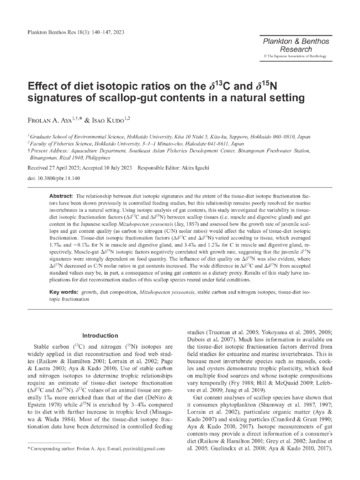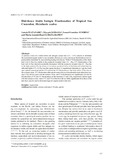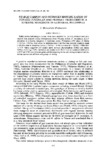Effect of diet isotopic ratios on the \(\mathsf{\delta^{13}C}\) and \(\mathsf{\delta^{15}N}\) signatures of scallop-gut contents in a natural setting
- Global styles
- MLA
- Vancouver
- Elsevier - Harvard
- APA
- Help

Download URL
www.jstage.jst.go.jpDate
2023Page views
361ASFA keyword
AGROVOC keyword
Taxonomic term
Metadata
Perlihat publikasi penuh
Share
Abstract
The relationship between diet isotopic signatures and the extent of the tissue-diet isotope fractionation factors have been shown previously in controlled feeding studies, but this relationship remains poorly resolved for marine invertebrates in a natural setting. Using isotope analysis of gut contents, this study investigated the variability in tissue-diet isotopic fractionation factors (Δδ13C and Δδ15N) between scallop tissues (i.e. muscle and digestive gland) and gut content in the Japanese scallop Mizuhopecten yessoensis (Jay, 1857) and assessed how the growth rate of juvenile scallops and gut content quality (as carbon to nitrogen (C/N) molar ratios) would affect the values of tissue-diet isotopic fractionation. Tissue-diet isotopic fractionation factors (Δδ13C and δ15N) varied according to tissue, which averaged 1.7‰ and −0.1‰ for N in muscle and digestive gland, and 3.4‰ and 1.2‰ for C in muscle and digestive gland, respectively. Muscle-gut δ15N isotopic factors negatively correlated with growth rate, suggesting that the juvenile δ15N signatures were strongly dependent on food quantity. The influence of diet quality on δ15N was also evident, where δ15N decreased as C/N molar ratios in gut contents increased. The wide difference in Δδ13C and δ15N from accepted standard values may be, in part, a consequence of using gut contents as a dietary proxy. Results of this study have implications for diet reconstruction studies of this scallop species reared under field conditions.
Keywords
growth diet composition Mizuhopecten yessoensis stable carbon and nitrogen isotopes tissue-diet isotopic fractionation Japanese scallop Ezo giant scallopSuggested Citation
Aya, F., & Kudo, I. (2023). Effect of diet isotopic ratios on the \(\mathsf{\delta^{13}C}\) and \(\mathsf{\delta^{15}N}\) signatures of scallop-gut contents in a natural setting. Plankton and Benthos Research , 18(3), 140-147. https://doi.org/10.3800/pbr.18.140
Type
ArticleISSN
1880-8247; 1882-627XKoleksi
- Journal Articles [1258]
Related items
Showing items related by title, author, creator and subject.
-
Seasonal growth, organ indices and food consumption of the Japanese scallop Patinopecten yessoensis (Jay, 1857) in relation to food availability in Tokoro seabed, Okhotsk Sea, North Japan
Aya, Frolan ; Kudo, Isao
; Kudo, Isao  (The Plankton Society of Japan (The Japanese Association of Benthology), 2022-05-30)
The coastal waters off Tokoro, Okhotsk Sea have been characterized by a substantial decrease in primary production from spring to summer season which will have repercussions on the maintenance of the Japanese scallop ...
(The Plankton Society of Japan (The Japanese Association of Benthology), 2022-05-30)
The coastal waters off Tokoro, Okhotsk Sea have been characterized by a substantial decrease in primary production from spring to summer season which will have repercussions on the maintenance of the Japanese scallop ... -
Diet-tissue stable isotopic fractionation of tropical sea cucumber, Holothuria scabra
Watanabe, Satoshi; Kodama, Masashi; Sumbing, Joemel Gentelizo; Lebata-Ramos, Maria Junemie Hazel (Japan International Research Center for Agricultural Sciences (JIRCAS), 2013)
To provide a basis for a stable carbon and nitrogen isotope ratio \(\mathsf{(\delta^{13}C / \delta^{15}N)}\) analysis to determine the assimilated organic matter in sea cucumber, Holothuria scabra, diet-tissue fractionations ...
(Japan International Research Center for Agricultural Sciences (JIRCAS), 2013)
To provide a basis for a stable carbon and nitrogen isotope ratio \(\mathsf{(\delta^{13}C / \delta^{15}N)}\) analysis to determine the assimilated organic matter in sea cucumber, Holothuria scabra, diet-tissue fractionations ... -
Stable carbon and nitrogen isotope ratios of penaeid juveniles and primary producers in a riverine mangrove in Guimaras, Philippines
Primavera, Jurgenne (University of Miami, Rosenstiel School of Marine and Atmospheric Science, 1996)
Stable carbon and nitrogen isotope ratios were analyzed for primary producers and juveniles of four penaeid species (Metapenaeus ensis, Penaeus indicus, P. merquiensi and P. monodon) in a riverine mangrove in Guimaras, ...
(University of Miami, Rosenstiel School of Marine and Atmospheric Science, 1996)
Stable carbon and nitrogen isotope ratios were analyzed for primary producers and juveniles of four penaeid species (Metapenaeus ensis, Penaeus indicus, P. merquiensi and P. monodon) in a riverine mangrove in Guimaras, ...





